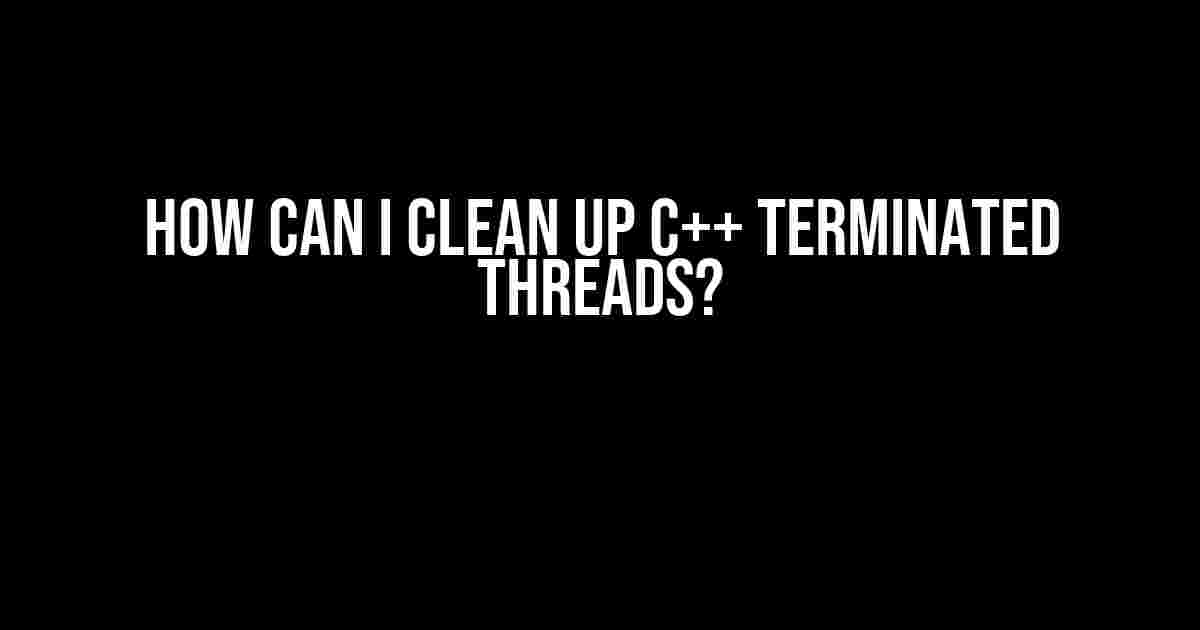Are you tired of dealing with the aftermath of terminated threads in your C++ program? Do you find yourself wondering how to clean up the mess left behind by those rogue threads? Fear not, dear developer, for we’re about to dive into the world of thread cleanup and provide you with the ultimate guide on how to keep your threads tidy and organized.
What Happens When a Thread Terminates?
Before we dive into the cleaning process, let’s take a step back and understand what happens when a thread terminates in C++. When a thread terminates, it doesn’t just magically disappear; it leaves behind a trail of resources that need to be cleaned up. These resources can include:
- Memory allocated by the thread
- Open file handles and sockets
- System resources, such as mutexes and semaphores
- Thread-specific data, such as thread-local variables
If these resources are not properly cleaned up, they can lead to:
- Memory leaks
- Resource starvation
- System crashes and instability
- Hard-to-debug issues and errors
Cleaning Up Terminated Threads in C++
Now that we’ve covered the importance of cleaning up terminated threads, let’s dive into the nitty-gritty of how to do it. There are several ways to clean up terminated threads in C++, but we’ll focus on the most common and effective methods.
Method 1: Joining Threads
The simplest way to clean up a terminated thread is to use the `join()` function. When you call `join()` on a thread, it waits for the thread to finish execution and then cleans up the thread’s resources.
#include <iostream>
#include <thread>
void myThreadFunction() {
// Do some work
}
int main() {
std::thread t(myThreadFunction);
t.join(); // Wait for the thread to finish and clean up resources
return 0;
}
Note that if the thread has already terminated when you call `join()`, the function will return immediately.
Method 2: Detaching Threads
Alternatively, you can detach a thread using the `detach()` function. When you detach a thread, it runs independently of the main program, and its resources are cleaned up automatically when it terminates.
#include <iostream>
#include <thread>
void myThreadFunction() {
// Do some work
}
int main() {
std::thread t(myThreadFunction);
t.detach(); // Let the thread run independently and clean up resources automatically
return 0;
}
However, be careful when using `detach()` as it can lead to resource leaks if not used carefully.
Method 3: Using Thread RaII (Resource Acquisition Is Initialization)
A more modern approach to cleaning up terminated threads is to use a RAII (Resource Acquisition Is Initialization) class. A RAII class acquires resources in its constructor and releases them in its destructor. This ensures that resources are always cleaned up, even in the presence of exceptions.
#include <iostream>
#include <thread>
class ThreadRAII {
public:
ThreadRAII(std::thread t) : t_(std::move(t)) {}
~ThreadRAII() { if (t_.joinable()) t_.join(); }
private:
std::thread t_;
};
void myThreadFunction() {
// Do some work
}
int main() {
ThreadRAII t(std::thread(myThreadFunction));
return 0;
}
In this example, the `ThreadRAII` class takes ownership of the thread and ensures that it is joined and cleaned up when the object goes out of scope.
Additional Tips and Best Practices
Cleaning up terminated threads is just one part of the puzzle. Here are some additional tips and best practices to keep in mind:
| Tips and Best Practices | Description |
|---|---|
| Avoid using `std::terminate()` | `std::terminate()` is a last resort and can lead to resource leaks and system crashes. |
| Use `std::thread` instead of raw threads | `std::thread` provides a higher-level abstraction and handles cleanup automatically. |
| Use thread-safe data structures | Ensure that shared data structures are thread-safe to avoid data corruption and race conditions. |
| Handle exceptions properly | Use try-catch blocks to handle exceptions and ensure that resources are cleaned up even in the presence of errors. |
| Profile and test your code | Use profiling tools and testing frameworks to ensure that your code is thread-safe and resource-efficient. |
By following these tips and best practices, you can ensure that your C++ program is thread-safe, efficient, and free from resource leaks.
Conclusion
Cleaning up terminated threads in C++ is a crucial aspect of writing robust and efficient code. By using `join()`, `detach()`, or RAII classes, you can ensure that resources are properly cleaned up and your program remains stable and thread-safe. Remember to follow best practices, handle exceptions properly, and profile and test your code to ensure that it meets the highest standards of quality.
With this comprehensive guide, you’re now equipped to tackle the challenge of thread cleanup and write C++ code that’s both efficient and reliable. So go ahead, write threads with confidence, and remember: a clean thread is a happy thread!
Frequently Asked Question
Cleaning up C++ terminated threads can be a daunting task, but fear not, dear developer! We’ve got the answers to get you out of this messy situation.
What happens if I don’t clean up terminated threads?
If you don’t clean up terminated threads, your program will continue to allocate memory for those threads, leading to memory leaks and potential crashes. It’s like leaving a bunch of zombies roaming around in your code, taking up space and causing chaos!
How do I know if a thread has terminated?
You can use the `join()` function to wait for a thread to finish, and then check the return value of `join()` to see if the thread has terminated. Alternatively, you can use `std::thread::joinable()` to check if the thread is still running. Easy peasy!
What’s the deal with `std::thread::~thread()`?
When a `std::thread` object is destroyed, the thread is automatically detached if it’s still running. This means the thread will continue running in the background, but you won’t be able to join it or get its return value. So, make sure to `join()` or `detach()` your threads before they go out of scope!
Can I use `std::async` to clean up terminated threads?
While `std::async` does provide a way to run threads asynchronously, it doesn’t directly help with cleaning up terminated threads. However, you can use `std::future` objects returned by `std::async` to check if the thread has finished and then join it. So, it’s indirect, but it gets the job done!
What’s the best way to clean up terminated threads in a multithreaded program?
The best approach is to use a thread pool or a scheduler that manages threads for you. These libraries often provide mechanisms for cleaning up terminated threads automatically. If you’re rolling your own, make sure to use smart pointers and ensure that threads are properly joined or detached before going out of scope. Happy cleaning!


